JournalPTEP
-
PICKUP
 Characterizing Quantum Chaos: Exact Analytical Expression for Gap Ratio Distribution
Characterizing Quantum Chaos: Exact Analytical Expression for Gap Ratio Distribution2025-2-27
This study presents the exact analytical expressions for gap ratio distribution, which is widely used to measure the chaoticity of quantum systems in many-body systems.
General and Mathematical Physics
-
 Understanding Global Inconsistency and ’t Hooft Anomaly Using Simple Quantum Mechanics
Understanding Global Inconsistency and ’t Hooft Anomaly Using Simple Quantum Mechanics2025-2-21
This study explores the implications of global inconsistency and ’t Hooft anomalies for analyzing quantum field theories, using simple quantum mechanical models to provide valuable insights into these complex phenomena.
Theoretical Particle Physics
-
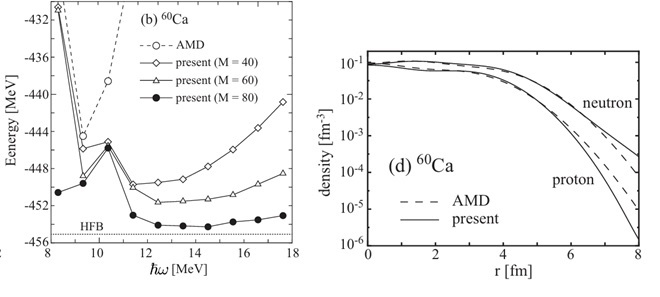 Implementation of Nuclear Many-Body Wave Functions via Superpositions of Localized Gaussians
Implementation of Nuclear Many-Body Wave Functions via Superpositions of Localized Gaussians2025-1-9
An extended version of antisymmetrized molecular dynamics integrated with a mean-field model is proposed, and its potential is demonstrated.Nuclear physics
-
 New Insights into Finite Temperature Large-N Gauge Theories
New Insights into Finite Temperature Large-N Gauge Theories2024-12-4
This study explores the thermodynamic properties of finite-temperature large-N gauge theories, revealing two significant discoveries that could be instrumental for understanding the strong nuclear force and quantum gravity.
Elementary particles, fields, and strings
-
 A Promising Solution to Nucleon–Nucleon Inverse Scattering Problem
A Promising Solution to Nucleon–Nucleon Inverse Scattering Problem2024-10-7
This study deals with the inverse elastic two-body quantum scattering problem using Volterra approximations and neural networks, offering a novel approach for solving complex nonlinear systems.
General and Mathematical Physics
Mathematical methods, classical and quantum physics, relativity, gravitation, numerical simulation, computational modeling
Nuclear physics
-
PICKUP
 A New Method for Finding Bound States in the Continuum
A New Method for Finding Bound States in the Continuum2024-10-1
This study presents a general theory for constructing potentials supporting bound states in the continuum, offering a method for identifying such states in real quantum systems.General and Mathematical Physics
Mathematical methods, classical and quantum physics, relativity, gravitation, numerical simulation, computational modeling
Nuclear physics
-
PICKUP
 Understanding Non-Invertible Symmetries in Higher Dimensions Using Topological Defects
Understanding Non-Invertible Symmetries in Higher Dimensions Using Topological Defects2024-9-27
By constructing Kramers-Wannier-Wegner duality and Z2 duality defects and deriving their crossing relations, this study presents the first examples of codimension one non-invertible symmetries in four-dimensional quantum field theories.Theoretical Particle Physics
-
PICKUP
 General Quasi-Joint Probabilities on Finite-State Quantum Systems
General Quasi-Joint Probabilities on Finite-State Quantum Systems2024-8-15
This study investigates the properties of general quasi-joint probability distributions in finite-state quantum systems, revealing the Kirkwood-Dirac distribution as among the most favorable. This highlights the importance of complex distributions in understanding quantum probability.
Mathematical methods, classical and quantum physics, relativity, gravitation, numerical simulation, computational modeling
-
PICKUP
 Quantum Mechanics of One-Dimensional Three-Body Contact Interactions
Quantum Mechanics of One-Dimensional Three-Body Contact Interactions2024-2-13
The quantum mechanical description of topologically nontrivial three-body contact interactions in one dimension is not well understood. This study explores the Hamiltonian description of these interactions using the path-integral formalism.
Mathematical methods, classical and quantum physics, relativity, gravitation, numerical simulation, computational modeling
Theoretical Particle Physics
-

Investigating Unitarity Violation of Lee–Wick’s Complex Ghost with Quantum Field Theory
2024-1-19
Theories with fourth-order derivatives like Lee–Wick’s quantum electrodynamics model or quadratic gravity result in complex ghosts above a definite energy threshold that violate unitarity.Theoretical Particle Physics
-
PICKUP
 Highly Accurate Estimation of Beta Decay Rates for Heavy Nuclei
Highly Accurate Estimation of Beta Decay Rates for Heavy Nuclei2023-11-7
Physicists from Japan present complete formulas that consider the induced current and velocity-dependent terms for estimating the beta decay rates in heavy nuclei with high accuracy.
Nuclear physics
-
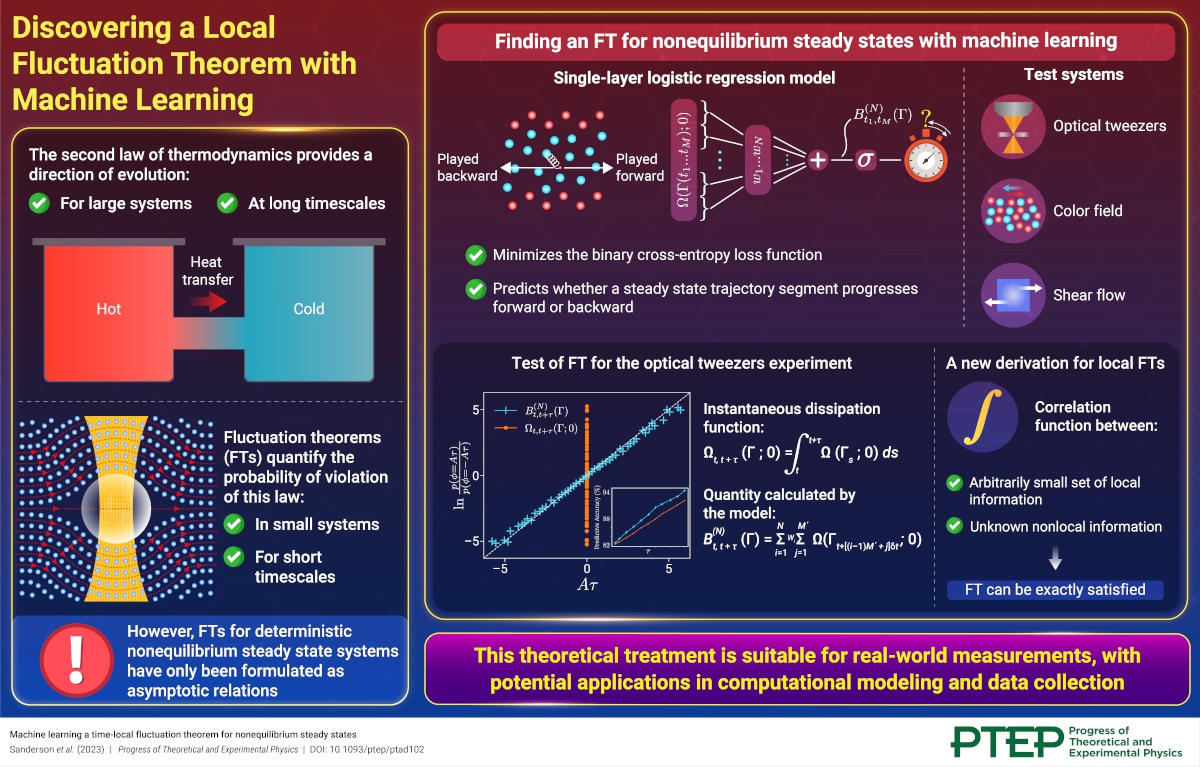 Discovering a Local Fluctuation Theorem with Machine Learning
Discovering a Local Fluctuation Theorem with Machine Learning2023-10-20
A groundbreaking study reveals a new time-local fluctuation theorem using machine learning, revolutionizing our understanding of deterministic nonequilibrium steady state systems.
Fundamental Theory of Condensed Matter Physics, Statistical Mechanics, Fluid Dynamics,
Measurement, instrumentation, and techniques
Statistical physics and thermodynamics
-
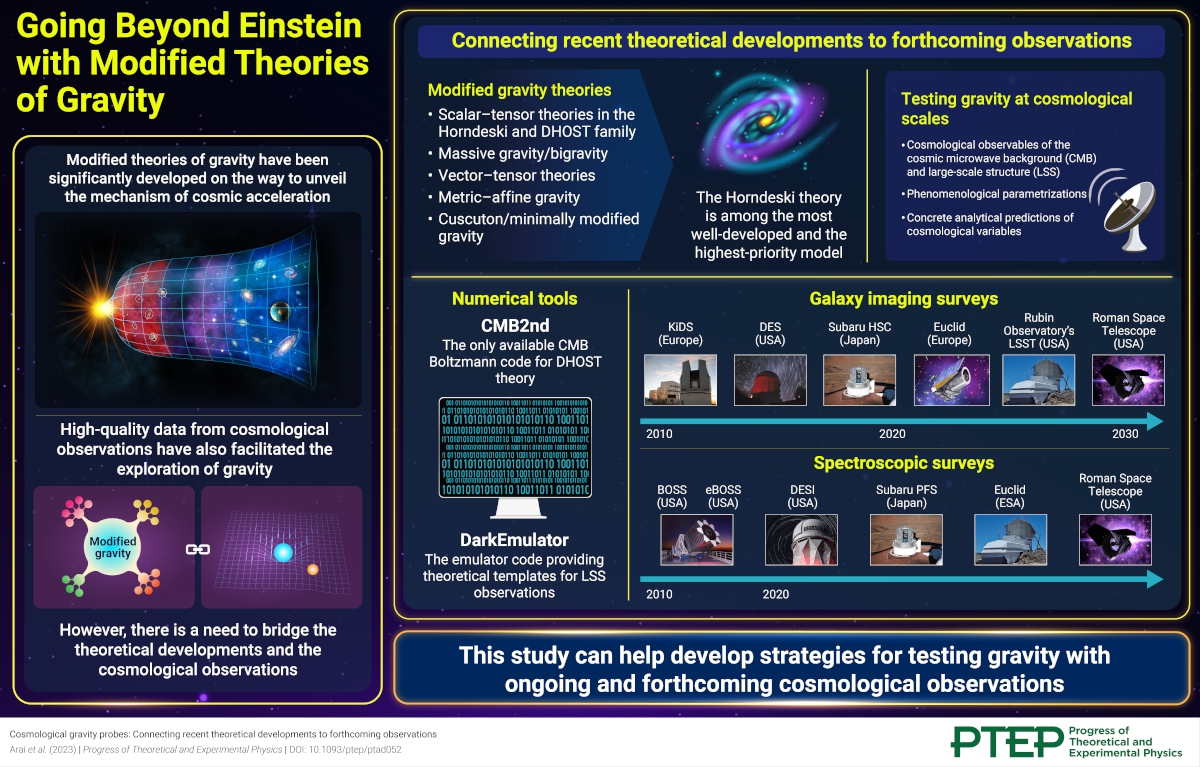 Going Beyond Einstein with Modified Theories of Gravity
Going Beyond Einstein with Modified Theories of Gravity2023-9-8
This study comprehends a way to probe modified theories of gravity on cosmological scales by combining theoretical advancements and observational data for upcoming cosmological observations.
Astrophysics, cosmology, and geophysics
-
 Investigating Δ and Ω Baryons as Meson–Baryon Bound States in Lattice Quantum Chromodynamics
Investigating Δ and Ω Baryons as Meson–Baryon Bound States in Lattice Quantum Chromodynamics2023-7-13
We investigate Δ and Ω baryons as meson–baryon bound states in lattice quantum chromodynamics and show that their difference results from the kinematic structure of the two meson–baryon systems, and not their interaction.
Theoretical Particle Physics
-

Novel Insights Into Bulk Reconstruction in the Anti-de Sitter/Conformal Field Theory Correspondence
2023-6-1
Bulk reconstruction in anti-de Sitter/conformal field theory is fundamental to our understanding of quantum gravity. We show that contrary to popular belief, bulk reconstruction is rather simple and intuitive.Theoretical Particle Physics
-

The Stolz–Teichner Conjecture and Supermoonshine
2023-4-25
We check the validity of the "divisibility property," predicted by the Stolz–Teichner conjecture, for several infinite families of theories built from Duncan’s Supermoonshine module. Along the way, we develop the tools necessary to construct the so-called "periodicity class."Theoretical Particle Physics
-
 A Closed Bosonic String Field Theory Based on the Fokker–Planck Formalism
A Closed Bosonic String Field Theory Based on the Fokker–Planck Formalism2023-4-11
A string field theory for closed bosonic strings is formulated using pants decomposition and the Fokker–Planck formalism.Theoretical Particle Physics
-
PICKUP
 Pushing the Frontiers: On the Tenth Anniversary of Progress of Theoretical and Experimental Physics
Pushing the Frontiers: On the Tenth Anniversary of Progress of Theoretical and Experimental Physics2023-3-30
The journal Progress of Theoretical and Experimental Physics (PTEP) celebrates its tenth (10th) anniversary in 2023. On this occasion, we take stock of some of its most notable publications.
-
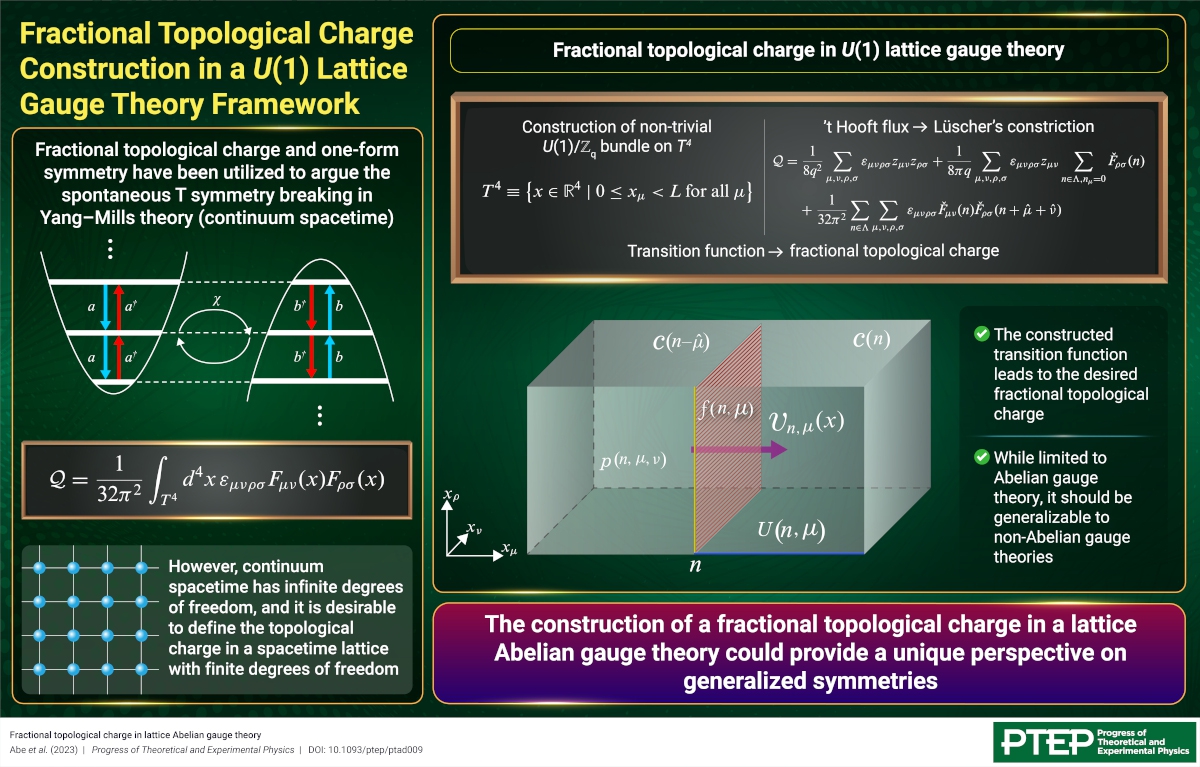
Fractional Topological Charge Construction in a U(1) Lattice Gauge Theory Framework
2023-3-27
We have constructed a fractional topological charge in the lattice Abelian gauge theory formalism, which avoids the issue of infinite degrees of freedom in continuum spacetime quantum field theory.
Theoretical Particle Physics
-
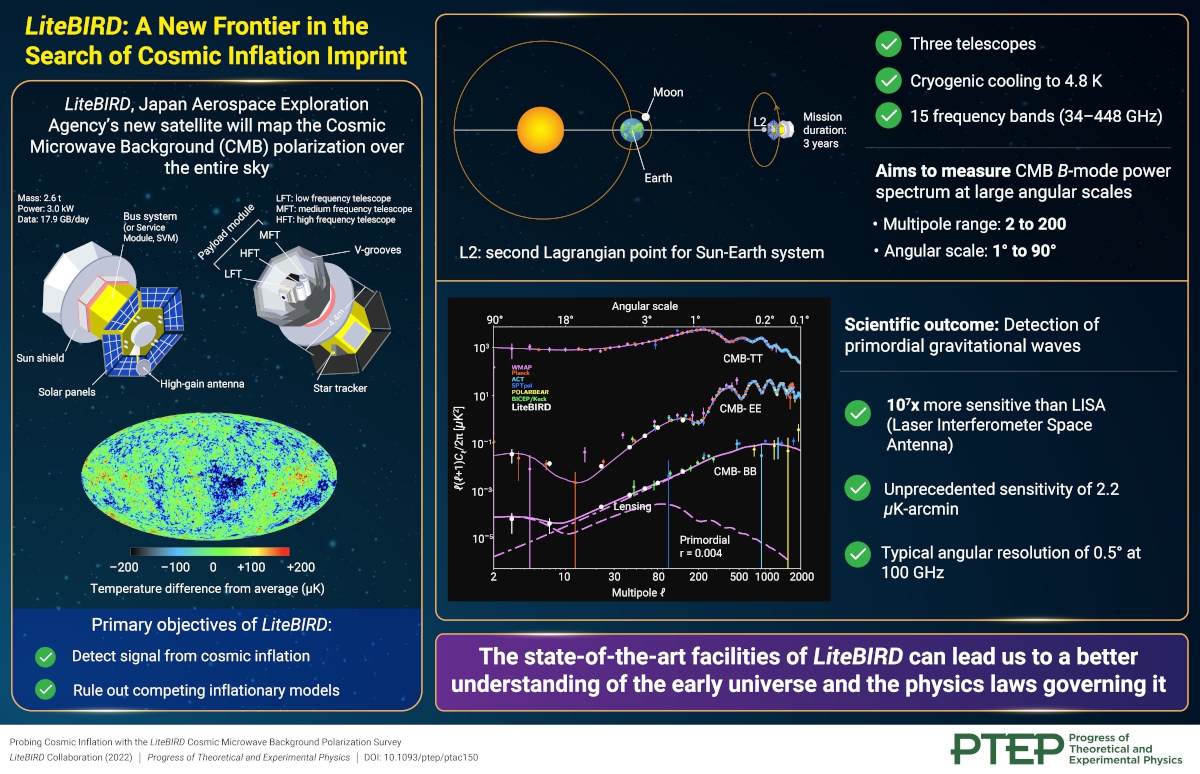
LiteBIRD: A New Frontier in the Search of Cosmic Inflation Imprint
2023-3-22
The newly selected LiteBIRD satellite aims to detect cosmic inflation signals by identifying the imprint of primordial gravitational waves in the Cosmic Microwave Background polarization.
Astrophysics, cosmology, and geophysics
-

Theoretical Assessment of F-wave Bottom Mesons and Their Properties
2022-11-24
We use heavy quark effective theory to study F-wave bottom mesons. Using theory and experimental data, we calculate their masses and analyze their decay widths to estimate the upper bound to the associated couplings.Theoretical Particle Physics
-
PICKUP
 Towards a Better Understanding of the Short-range Repulsive Nuclear Force
Towards a Better Understanding of the Short-range Repulsive Nuclear Force2022-11-21
In a new study, researchers provide an experimental estimate of the short-range repulsive nuclear force strength based on a high-statistics measurement of the differential cross-section for Σ+p scattering.
Nuclear physics
-

Representations of KBc Algebra for Generating String Field Theory Solutions
2022-10-31
We propose a general method for generating solutions in string field theory from a solution constructed using KBc algebra, and reproduce known solutions constructed earlier using different methods.Theoretical Particle Physics
-
PICKUP
 Open String Field Theory Beyond Feynman Diagrams
Open String Field Theory Beyond Feynman Diagrams2022-8-9
Theoretical physicists propose an alternative way of performing perturbative calculations in an open string field theory that has no analogy in the standard quantum field theory formalism.
Elementary particles, fields, and strings
Theoretical Particle Physics
-
PTEP SPECIAL SECTION

New Phases of Matter: Topological Physics in the 21st Century
2022-7-19
Researchers from Japan highlight in an editorial our current understanding of topological phases of matter, focusing on the classification of the newly discovered symmetry protected topological phases.Fundamental Theory of Condensed Matter Physics, Statistical Mechanics, Fluid Dynamics,
Superconductivity
Theoretical Particle Physics
-
PICKUP
 Calculating Impedances for a Particle Accelerator
Calculating Impedances for a Particle Accelerator2022-7-7
In a new study, scientists provide a more comprehensive picture of dealing with the impedances of a two-dimensional conductive cylindrical beam pipe with walls of finite thickness and space-charge forces simultaneously.
Beam Physics
-
PICKUP
 Testing the Viability of Muon Accelerators
Testing the Viability of Muon Accelerators2022-6-21
Researchers demonstrate the viability of a radio-frequency linear accelerator to accelerate stopped muons to the speed of light.
Experimental Particle Physics
-
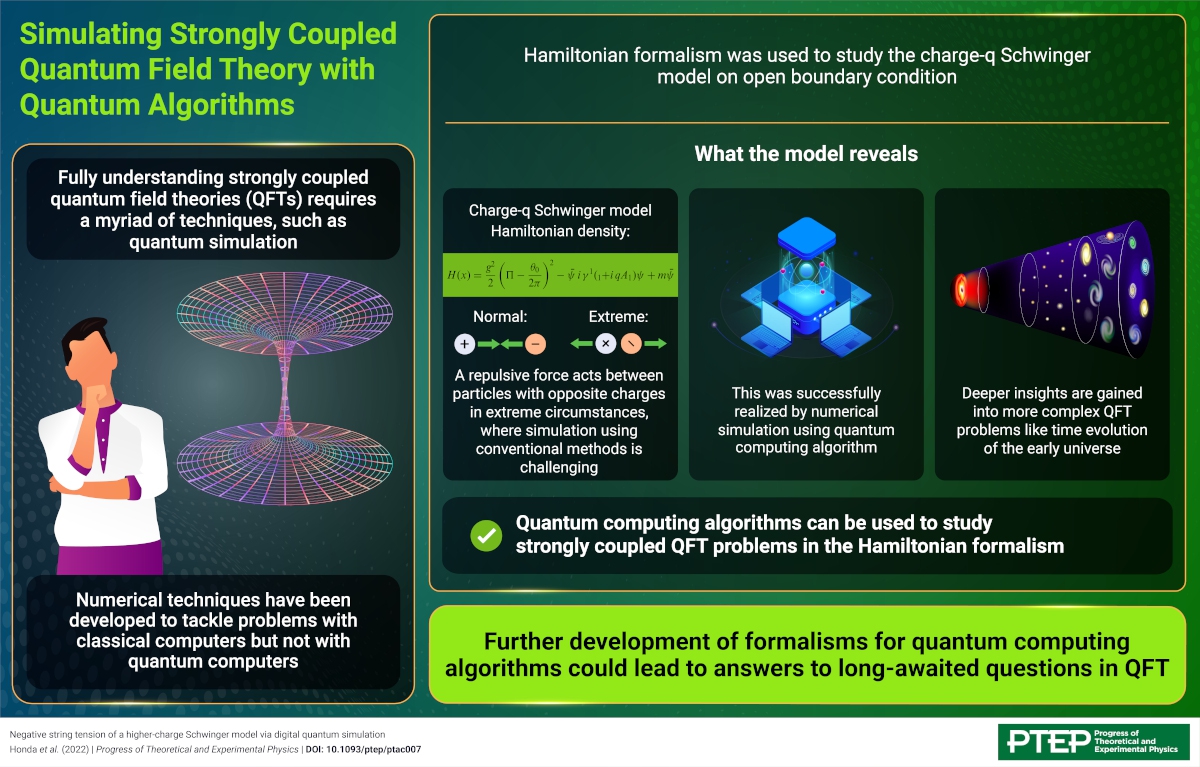 Simulating Strongly Coupled Quantum Field Theory with Quantum Algorithms
Simulating Strongly Coupled Quantum Field Theory with Quantum Algorithms2022-5-27
Nonperturbative quantum field theory problems can often be difficult to solve with classical algorithms. Researchers now develop quantum computing algorithms to understand such problems in the Hamiltonian formalism.
Theoretical Particle Physics
-

Getting Around the Sign Problem to Solve an Open Quantum System
2022-5-18
Researchers from Japan have found a novel non-equilibrium quantum system that doesn’t have the sign problem. The transport properties of the system are simulated with a Monte Carlo approach.Elementary particles, fields, and strings
Theoretical Particle Physics
-
PICKUP
 Quantum Anomaly in a Dirac Fermion System with Spacetime Dependent Mass
Quantum Anomaly in a Dirac Fermion System with Spacetime Dependent Mass2022-4-27
Scientists investigate quantum anomalies in a system of Dirac fermions with spacetime dependent mass and show that the anomaly formulas can be expressed in terms of superconnections.
Elementary particles, fields, and strings
Theoretical Particle Physics
-

Calculating Superconformal Index of 𝓝 = 4 Super-Yang-Mills Theory for Finite N
2022-2-22
The examination of AdS/CFT correspondence for finite N, where quantum gravitational effects become important, reveals that finite N corrections for the superconformal index can be reproduced as D-3 brane contributions.Theoretical Particle Physics
-
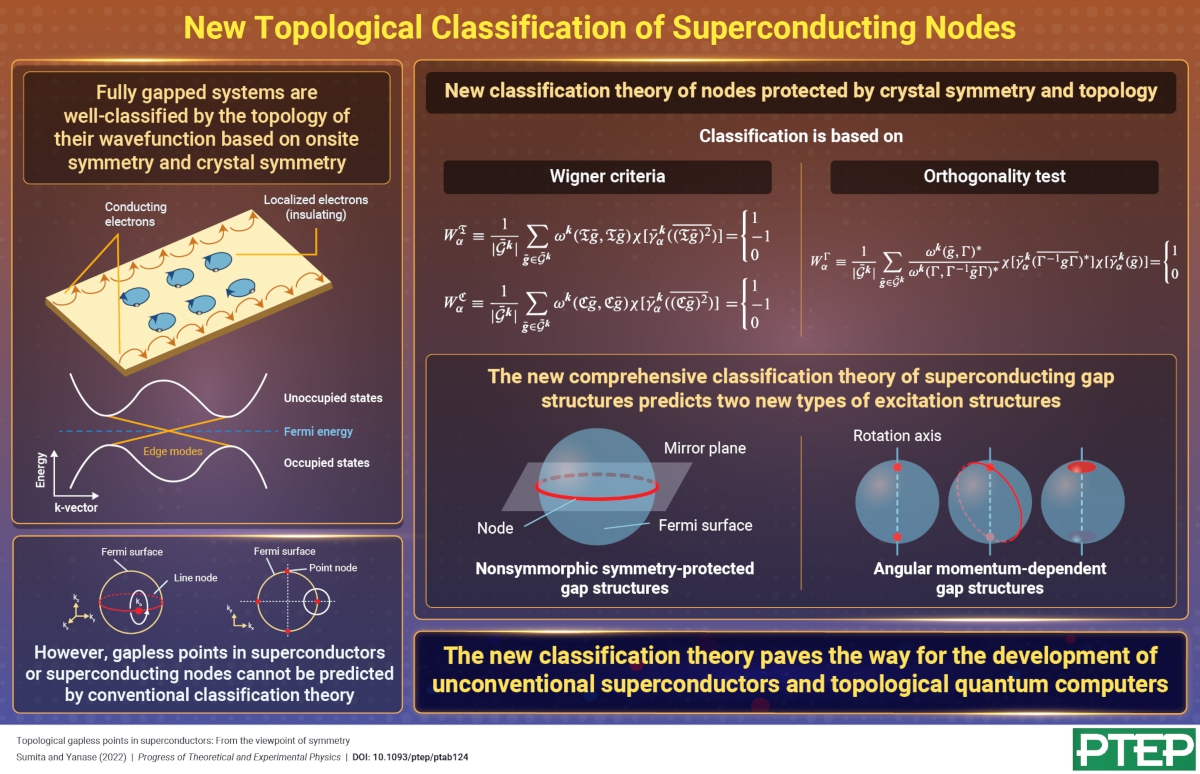 New Classification Theory for Topological Gapless Superconducting Nodes
New Classification Theory for Topological Gapless Superconducting Nodes2021-12-28
A new classification theory on topological superconducting gap nodes predicts two new gap structures emerging from a nonsymmorphic crystal symmetry and angular momentum.
Superconductivity
-
PICKUP
 Understanding Phase Transitions in Supersymmetric Quantum Electrodynamics With Resurgence Theory
Understanding Phase Transitions in Supersymmetric Quantum Electrodynamics With Resurgence Theory2021-11-25
Using resurgence theory to describe phase transitions in quantum field theory shows that information on non-perturbative effects like phase transitions can be obtained from a perturbative series expansion.
Theoretical Particle Physics
-
PICKUP
 A New Look at Our Universe with Gravitational Wave Astronomy
A New Look at Our Universe with Gravitational Wave Astronomy2021-10-26
A new interdisciplinary collaborative project underscores the importance of combining theory with advanced observation techniques to understand gravitational waves and their sources, opening doors to new discoveries about the universe.
Astrophysics, cosmology, and geophysics
-
PICKUP
 Estimating Beta Decay Rates Better for Exotic Nuclei
Estimating Beta Decay Rates Better for Exotic Nuclei2021-10-1
Physicists from Japan demonstrate an improved estimation of the beta decay rate in heavy nuclei by considering next-to-leading-order approximation for the electron wave function distorted by the Coulomb potential.
Nuclear physics
-
PICKUP
 Designing a New Space-borne Interferometer to Probe the History of Our Universe
Designing a New Space-borne Interferometer to Probe the History of Our Universe2021-9-22
Scientists present a new design for a space-born laser interferometer that could detect gravitational waves below 10 Hz, letting us probe into new astrophysical phenomena.
Astrophysics, cosmology, and geophysics
-
PICKUP
 Generalizing Poisson Algebra with Geometry
Generalizing Poisson Algebra with Geometry2021-9-6
Using a differential geometric interpretation of Hamiltonian mechanics, a generalized Poisson bracket formulation is developed for a three-dimensional phase space characterized by a triplet of canonical variables.
Mathematical methods, classical and quantum physics, relativity, gravitation, numerical simulation, computational modeling
-
PTEP SPECIAL SECTION
 Atoms Trapped with Light Behave Like a Dissipative Quantum System
Atoms Trapped with Light Behave Like a Dissipative Quantum System2021-7-19
A team of researchers from Japan experimentally realize, for the first time, a dissipative, parity-time symmetric, many-body quantum system from ultracold atoms trapped in an optical lattice.Gases, plasmas, electric discharges, accelerators, and beams
Mathematical methods, classical and quantum physics, relativity, gravitation, numerical simulation, computational modeling
-
PTEP SPECIAL SECTION
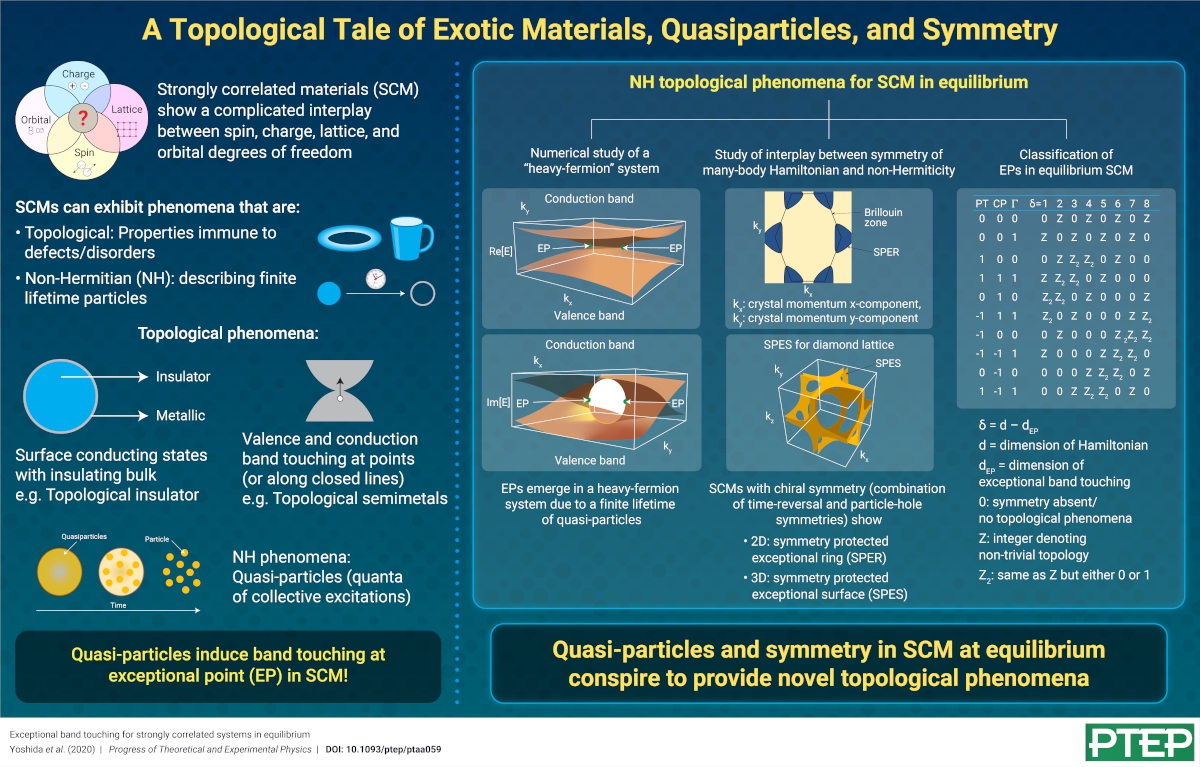 Non-real Energies with Real Effects in Exotic Condensed Matter Systems
Non-real Energies with Real Effects in Exotic Condensed Matter Systems2021-7-19
Scientists demonstrate the presence of non-Hermitian topological properties preserved under continuous physical deformations in strongly correlated systems in equilibrium, resulting from short-lived quanta of collective excitations.Electron states in condensed matter
-
PTEP SPECIAL SECTION
 A Quantum Description of Physical Systems with Non-real Energies
A Quantum Description of Physical Systems with Non-real Energies2021-7-19
While quantum systems are traditionally described by Hermitian Hamiltonians, the formalism is extendable to a non-Hermitian description for systems that are dissipative or obey parity-time symmetry.Electron states in condensed matter
Gases, plasmas, electric discharges, accelerators, and beams
Mathematical methods, classical and quantum physics, relativity, gravitation, numerical simulation, computational modeling
Nuclear physics
-
PICKUP
 Using Pulsed Cold Neutrons to Measure Neutron Lifetime
Using Pulsed Cold Neutrons to Measure Neutron Lifetime2021-7-13
Scientists measure the lifetime of a neutron with pulsed neutron beams to explore the cause of a puzzling discrepancy in their previously measured lifetime.
Elementary particles, fields, and strings
-
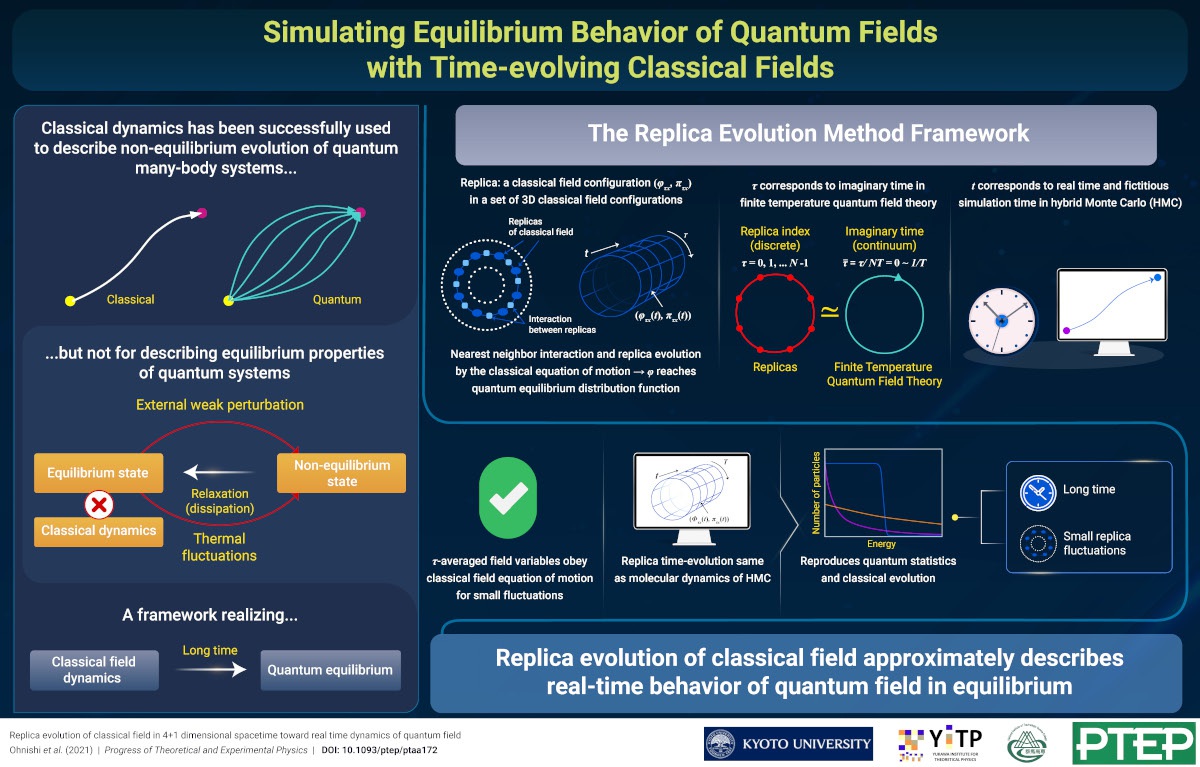 Simulating Equilibrium Behavior of Quantum Fields with Time-evolving Classical Fields
Simulating Equilibrium Behavior of Quantum Fields with Time-evolving Classical Fields2021-4-5
A set of field configurations (replicas) reaches equilibrium of quantum field theory after real-time evolution obeying classical equations of motion.
Elementary particles, fields, and strings
-
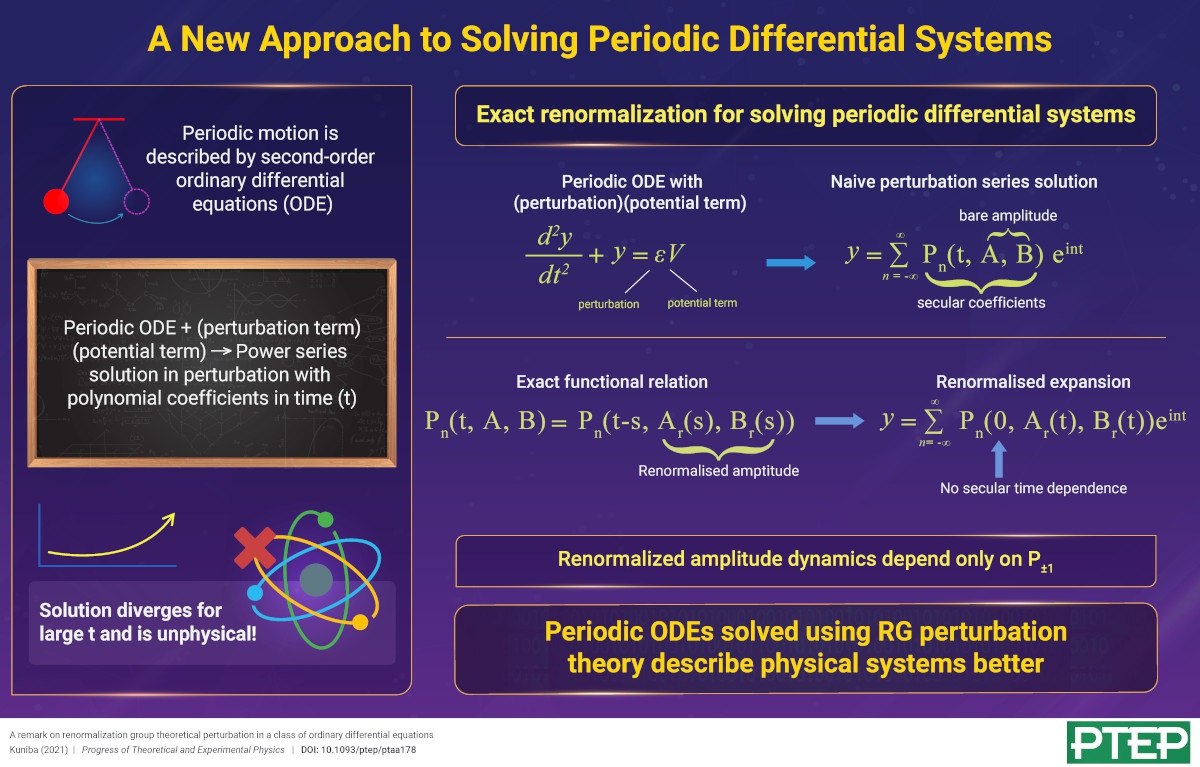 A New Approach to Solving Periodic Differential Systems
A New Approach to Solving Periodic Differential Systems2021-3-29
Mathematicians and physicists are well acquainted with second-order ordinary differential equations (ODE), the most prominent of them being the class of equations that govern oscillatory motion.
Mathematical methods, classical and quantum physics, relativity, gravitation, numerical simulation, computational modeling
-
PICKUP

Antimatter Matters: Making Sense of the Matter–Antimatter Asymmetry at Japan’s Belle-II Facility
2021-3-22
Scientists embark on a quest to unravel the mysteries behind matter–antimatter asymmetry in our universe with the new Belle-II experiment at the SuperKEKB accelerator in Japan.
Elementary particles, fields, and strings
-
PICKUP

The Thin Edge of Entanglement Wedges and Progress in Quantum Gravity
2021-3-15
Scientists for the first time theoretically link quantum states and gravity, taking one step further in understanding the origins of gravity and opening doors to novel quantum applications.
Elementary particles, fields, and strings
-
PICKUP

New Findings Hint Towards Existence of Kaonic Nuclei and Hyper-nuclei
2021-3-3
Scientists reveal a new feature in nuclear physics: the existence of kaonic nuclei and hyper-nuclei. These findings can enhance our understanding of nature and contribute to technological progress.Nuclear physics
-

What Happened to Antimatter?
2021-3-3
The Belle-II experiment is designed to explore new mechanisms of matter-antimatter asymmetry that may resolve the mystery behind the dominance of matter over anti-matter in the universe.Elementary particles, fields, and strings

